7-day vegetarian keto meal plan pdf
- Published
- in Canada
The vegetarian keto diet combines plant-based eating with ketogenic principles, focusing on high-fat, low-carb, and moderate-protein intake․ It offers benefits like weight management, improved energy, and reduced inflammation․
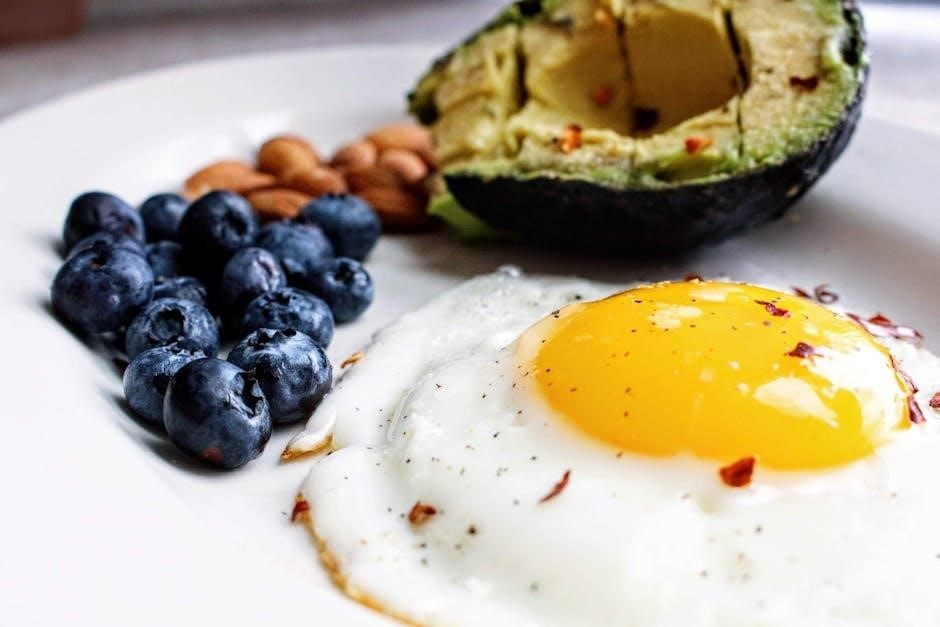
1․1 What is a Vegetarian Keto Diet?
A vegetarian keto diet is a plant-based eating plan that aligns with ketogenic principles, focusing on high-fat, low-carbohydrate, and moderate-protein intake․ It excludes meat, fish, and poultry, relying instead on eggs, dairy (optional), tofu, tempeh, nuts, seeds, and low-carb vegetables․ This diet aims to induce ketosis, a metabolic state where the body burns fat for energy․ By combining vegetarianism with keto, it offers a unique approach to weight loss, improved energy, and potential health benefits while maintaining ethical and dietary preferences․ The macronutrient breakdown typically includes 70-80% fats, 15-20% protein, and 5-10% net carbs per day․ This plan is versatile and can be tailored to suit individual needs and preferences․
1․2 Benefits of a Vegetarian Keto Diet
The vegetarian keto diet offers numerous health benefits, including weight management, improved energy levels, and reduced inflammation․ By focusing on plant-based, high-fat foods, it promotes heart health and supports blood sugar control․ This diet is rich in fiber and antioxidants from vegetables, nuts, and seeds, which can enhance overall well-being․ It also encourages mindful eating and sustainable weight loss․ Additionally, avoiding meat can lower saturated fat intake and reduce the risk of chronic diseases․ Many followers report improved mental clarity and reduced cravings․ With proper planning, the vegetarian keto diet can be a balanced and nutritious choice for those seeking a plant-based lifestyle․

Key Principles of a 7-Day Vegetarian Keto Meal Plan
The plan emphasizes high-fat, moderate-protein, and low-carbohydrate intake, focusing on plant-based foods like avocados, nuts, seeds, and non-starchy vegetables․ It prioritizes meal planning to ensure variety and adherence to keto guidelines․ By balancing macronutrients and avoiding high-carb foods, the diet helps maintain ketosis․ Incorporating healthy fats and protein sources like tofu and eggs supports energy levels and satisfaction․ Proper hydration and electrolyte balance are also crucial to avoid side effects․ Tracking meals and adjusting macros ensures sustainability․ This structured approach makes the vegetarian keto lifestyle accessible and sustainable, promoting weight loss and improved health outcomes․
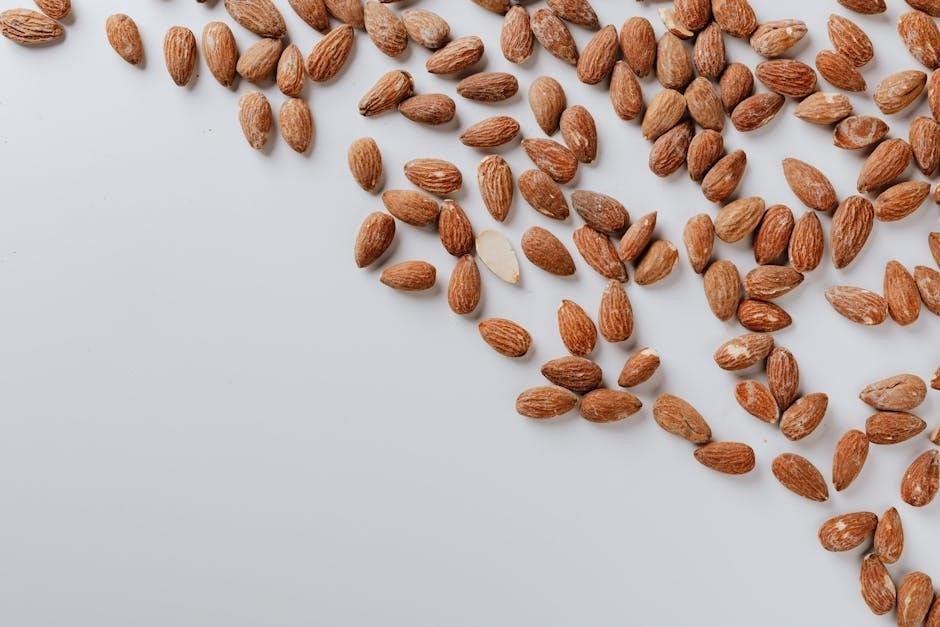
2․1 Macronutrient Breakdown: Fats, Proteins, and Carbohydrates
The vegetarian keto diet focuses on a macronutrient breakdown of approximately 70-75% fats, 20-25% protein, and 5-10% carbohydrates․ Fats are primarily sourced from avocados, nuts, seeds, and olive oil․ Proteins are derived from eggs, tofu, tempeh, and dairy products like Greek yogurt․ Carbohydrates are limited to low-carb, non-starchy vegetables such as spinach, broccoli, and cauliflower, with a daily net carb intake of 20-25 grams․ This balance ensures ketosis, where the body burns fat for energy․ Tracking macronutrients is essential to maintain this ratio and avoid exceeding carb limits․ Adjustments may be needed based on individual goals, such as weight loss or improved energy levels․ Proper macronutrient balance is key to the diet’s effectiveness and sustainability․
2․2 Foods to Eat and Avoid
A vegetarian keto diet emphasizes whole, nutrient-dense foods while minimizing high-carb and processed options․ Focus on healthy fats like avocados, nuts, seeds, and olive oil․ Protein sources include eggs, tofu, tempeh, and Greek yogurt․ Low-carb vegetables such as spinach, broccoli, and cauliflower are staples․ Avoid high-carb foods like grains, starchy vegetables, and legumes․ Sugary foods, tropical fruits, and refined oils should also be excluded․ Incorporate keto-friendly condiments and spices to enhance flavor․ Meal planning is crucial to ensure adherence to this macronutrient breakdown, helping maintain ketosis and support overall health goals․ Tracking what you eat and drink is essential to staying on track․
2․3 Importance of Meal Planning
Meal planning is essential for a successful vegetarian keto diet, ensuring variety and adherence to macronutrient goals․ By organizing meals in advance, you can avoid carb overconsumption and maintain ketosis․ Planning helps incorporate diverse protein sources and low-carb vegetables, preventing nutrient deficiencies․ It also saves time and reduces the risk of last-minute, high-carb choices․ A well-structured plan provides clarity and confidence, making the diet sustainable and enjoyable․ Additionally, tracking macros through meal planning helps tailor intake to individual needs, optimizing weight loss and energy levels․ A 7-day meal plan with detailed recipes and shopping lists simplifies the process, making it easier to stay committed and achieve long-term health benefits․ Consistency is key to maximizing the diet’s potential․
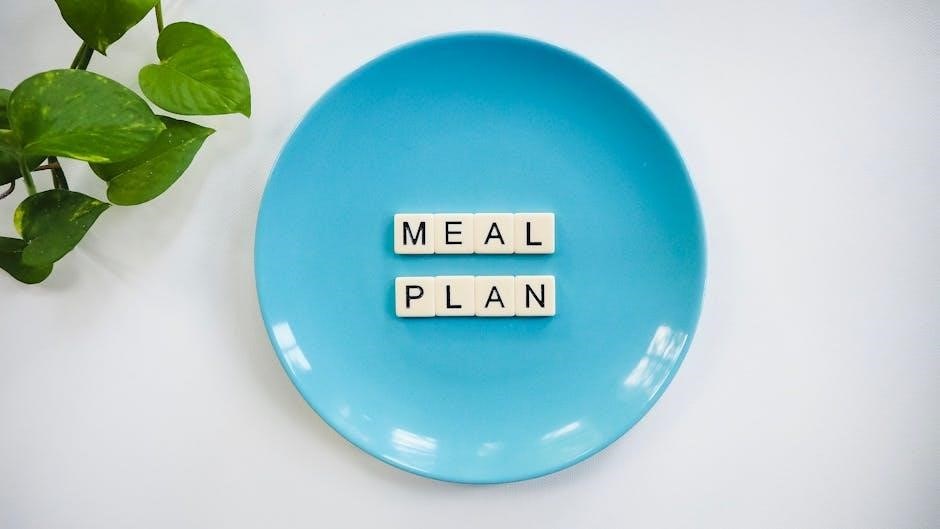
Preparing for Your 7-Day Vegetarian Keto Journey
Preparing for your 7-day vegetarian keto journey involves setting realistic goals, stocking essential ingredients, and using tracking tools to monitor progress and stay motivated․
3․1 Setting Realistic Goals
Setting realistic goals is essential for a successful 7-day vegetarian keto journey․ Define achievable objectives, such as adhering to the meal plan, tracking macros, or improving energy levels․ Aim for sustainable weight loss or enhanced health benefits, ensuring goals align with your lifestyle․ Start with small, manageable steps to build confidence and maintain motivation throughout the week․
Consider your daily calorie needs, typically around 1400-1500 kcal, and focus on balancing macronutrients to stay in ketosis․ Celebrate non-scale victories, like increased energy or better digestion, to stay encouraged․ Adjust goals as needed and remember, consistency is key to long-term success;
3․2 Essential Kitchen Ingredients
Stocking your kitchen with essential ingredients is crucial for a successful 7-day vegetarian keto meal plan․ Focus on healthy fats like olive oil, avocado oil, and coconut oil for cooking and dressings․ Include avocado, nuts, and seeds for added fat and protein․ Low-carb vegetables such as spinach, broccoli, cauliflower, and zucchini are staples․ Dairy or dairy alternatives like Greek yogurt and cheese provide protein and creaminess․ Eggs, tofu, and tempeh are great protein sources․ Don’t forget spices and herbs like turmeric, garlic powder, and basil to enhance flavors․ Always opt for low-carb, whole-food ingredients to maintain ketosis and support overall health․
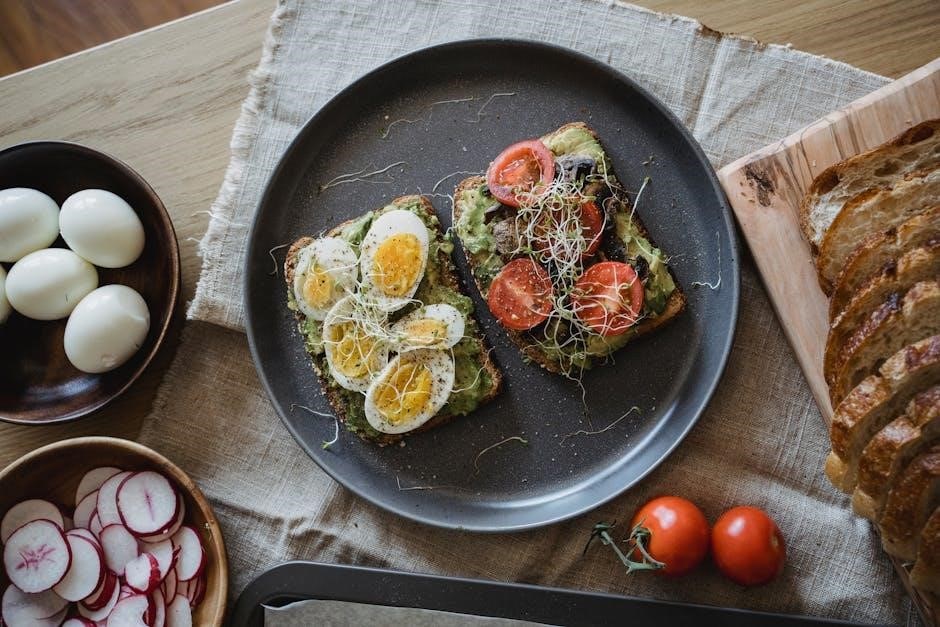
3․3 Tools for Tracking Progress
Tracking your progress on a 7-day vegetarian keto meal plan is essential for staying motivated and ensuring you meet your goals․ Use a food diary or apps like MyFitnessPal to monitor your daily macronutrient intake, ensuring you stay within keto guidelines․ A ketone testing kit can help verify if you’re in ketosis․ Regularly track your weight, measurements, and energy levels to observe improvements․ A food scale is also handy for precise portion control․ Additionally, progress photos and non-scale victories, like better digestion or reduced cravings, can provide encouragement․ These tools help you stay accountable and make necessary adjustments to optimize your ketogenic journey․

Day-by-Day Meal Plan Overview
This 7-day plan offers a structured roadmap, balancing flavors and nutrients each day․ It ensures variety, keeping meals exciting and aligned with keto and vegetarian guidelines․
Day 1 introduces you to the basics of vegetarian keto meals, starting with an Avocado and Egg Bowl for breakfast․ This dish combines fried eggs, sliced avocado, crumbled feta, and a drizzle of olive oil, providing a rich source of healthy fats and minimal carbs․ Lunch features a Keto Grilled Vegetable Chopped Salad with avocado dressing, highlighting low-carb vegetables like zucchini, bell peppers, and spinach․ Dinner includes Cauliflower Mac and Cheese, a creative low-carb take on a classic, using cauliflower instead of pasta․ Snacks like keto seeded crackers with goat cheese keep you satisfied throughout the day․ This first day sets the tone for a delicious and nutritious week ahead, ensuring a smooth transition into the vegetarian keto lifestyle․
4․2 Day 2: Balancing Flavors and Nutrients
Day 2 focuses on balancing flavors and nutrients while maintaining a ketogenic state․ Breakfast features chia seed pudding made with almond milk, chia seeds, and berries, offering a boost of omega-3s and fiber․ For lunch, a keto-friendly vegetable soup with ingredients like zucchini, spinach, and avocado ensures a variety of textures and tastes․ Dinner includes stuffed zucchini boats filled with a mix of ricotta, Parmesan, and fresh herbs, providing a satisfying and nutrient-dense meal․ Snacks like celery sticks with almond butter keep energy levels steady․ This day emphasizes the importance of diversifying ingredients to ensure a well-rounded intake of vitamins and minerals while staying within keto guidelines․
4․3 Day 3: Incorporating Low-Carb Vegetables
Day 3 highlights the importance of incorporating low-carb vegetables to add variety and nutrients to your meals․ Breakfast starts with a keto frittata packed with spinach, mushrooms, and feta cheese, providing a protein-rich start․ Lunch features a cauliflower mac and cheese, a creamy, low-carb alternative that satisfies cravings while staying ketogenic․ Dinner includes grilled portobello mushrooms marinated in olive oil and herbs, served alongside a side of roasted broccoli․ Snacks like cheese slices or handfuls of almonds help maintain fat intake․ This day showcases how low-carb vegetables can be creatively integrated into delicious, balanced meals that keep you in ketosis․
4․4 Day 4: High-Fat, High-Protein Options
Day 4 emphasizes high-fat and high-protein meals to keep you satisfied and in ketosis․ Breakfast features a keto smoothie with avocado, protein powder, almond milk, and chia seeds․ Lunch includes a tofu salad with olive oil dressing, mixed greens, and chopped nuts for added crunch and fats․ Dinner highlights stuffed zucchini boats filled with ricotta, spinach, and Parmesan, baked to perfection․ Snacks like macadamia nuts or cheese slices provide a quick protein and fat boost․ This day focuses on balancing flavors while ensuring meals are nutrient-dense, high in healthy fats, and protein-rich to support your ketogenic journey․
4․5 Day 5: Creative Meal Ideas
Day 5 introduces innovative recipes to keep your meals exciting and flavorful․ Start with keto zucchini pancakes made with almond flour and topped with a dairy-free yogurt sauce․ For lunch, try cauliflower gnocchi tossed in a creamy pesto sauce with roasted vegetables․ Dinner features eggplant lasagna rolls filled with ricotta and spinach, baked in a rich tomato sauce․ Snacks include keto chocolate mousse or cheese crisps for a satisfying crunch․ These creative dishes ensure variety while maintaining high fat and low-carb intake, keeping you engaged and energized throughout your ketogenic journey․
4․6 Day 6: Maintaining Variety
Day 6 focuses on keeping your meals diverse and engaging to prevent monotony․ Breakfast features keto stuffed peppers with scrambled eggs and avocado, while lunch includes a zucchini boat salad with hummus and olive tapenade․ Dinner highlights cauliflower pizza crust topped with marinara, vegan mozzarella, and fresh basil․ Snacks like keto fat bombs or cheesy broccoli bites add variety․ Incorporating different textures and flavors ensures your diet remains satisfying and prevents boredom․ This day emphasizes creativity, showing how versatile a ketogenic diet can be while staying true to vegetarian principles and macronutrient goals․
4․7 Day 7: Final Adjustments and Reflection
By Day 7, you’ve completed the foundational week of your vegetarian keto journey․ This day is about reflection and fine-tuning․ Breakfast includes keto chia pudding with coconut milk and berries, while lunch features a spinach and feta stuffed portobello mushroom․ Dinner is a hearty zucchini lasagna with dairy-free ricotta․ Snacks like ketogenic trail mix or cucumber slices with cashew dip round out the day․ Reflect on your progress, noting how your body responds to the diet․ Adjust macros or meal portions as needed for the upcoming week․ Celebrate small victories and plan to continue incorporating these healthy, flavorful meals into your lifestyle for sustained success․
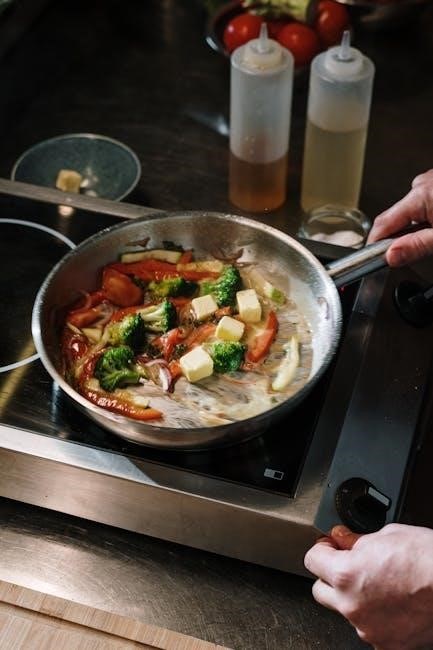
Sample Recipes for Each Meal
Discover delicious recipes like keto chia pudding, zucchini lasagna, and stuffed portobello mushrooms․ Each meal balances flavors and nutrients, ensuring a satisfying vegetarian keto experience with varied and tasty options daily․
5․1 Breakfast Recipes
Start your day with delicious keto-friendly breakfasts like chia pudding with almond milk and berries or scrambled eggs with spinach and avocado․ Try keto oatmeal made with almond flour for a hearty option․ Keto pancakes crafted from almond flour and eggs offer a tasty, low-carb alternative․ For a quick meal, enjoy a creamy avocado and feta bowl with olive oil drizzle․ These recipes are high in healthy fats, moderate in protein, and low in carbs, ensuring you stay in ketosis while satisfying your morning cravings․ Each dish is carefully designed to be both nutritious and flavorful, providing a great start to your day on the vegetarian keto journey․
5․2 Lunch Recipes
Enjoy a variety of keto-friendly lunch options that are both nutritious and flavorful․ Try stuffed peppers with cauliflower rice and vegan cheese for a colorful, low-carb meal․ Zucchini pasta with pesto and cherry tomatoes offers a refreshing twist, while a kale salad with avocado dressing and grilled tofu provides a satisfying crunch․ Keto-friendly wraps made with lettuce leaves and filled with avocado, hummus, and spinach are a great on-the-go option․ These recipes are designed to keep you in ketosis while delivering vibrant, plant-based flavors․ Each dish balances healthy fats, moderate protein, and minimal carbs, ensuring you stay energized and focused throughout the day․ Explore these creative ideas to make your vegetarian keto lunches both nourishing and delicious․
5․3 Dinner Recipes
Elevate your evenings with these delicious vegetarian keto dinner recipes․ Try stuffed zucchini boats filled with a rich mixture of ricotta, spinach, and Parmesan for a creamy, satisfying meal․ Cauliflower mac and cheese offers a comforting, low-carb twist on a classic dish․ For a hearty option, keto eggplant Parmesan with layers of tender eggplant, marinara, and melted mozzarella is a perfect choice․ Shirataki noodles with mushrooms provide a light yet flavorful meal, while veggie-packed keto curries with coconut milk and spices add an exotic touch․ Each recipe is carefully crafted to ensure high fat, low-carb, and moderate protein content, making them perfect for a ketogenic lifestyle․ These dinners are not only nutritious but also rich in variety to keep your meals exciting and satisfying․
5․4 Snack Ideas
Keep your energy levels steady with these delicious vegetarian keto snack ideas․ Try celery sticks with almond butter for a crunchy, protein-rich snack․ Mozzarella cheese sticks are an easy, portable option․ For something savory, macadamia nuts or cheese crisps are perfect․ Chia seed pudding with coconut milk and berries offers a sweet, low-carb treat․ Cucumber slices with hummus provide a refreshing and satisfying snack․ Keto fat bombs, made with coconut oil and cocoa butter, are a decadent way to stay in ketosis․ These snacks are designed to keep you fueled and focused throughout the day while adhering to your vegetarian keto lifestyle․
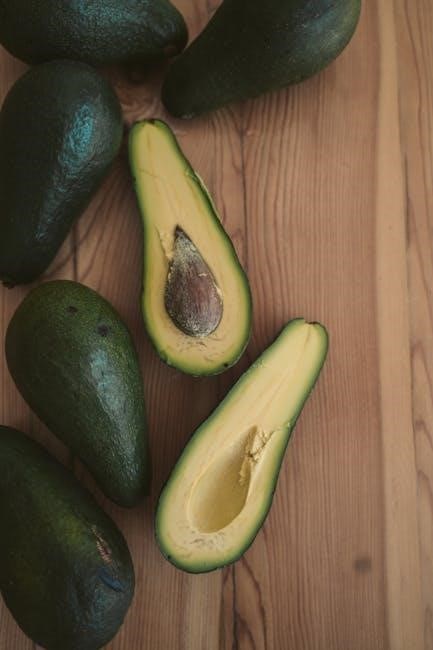
Tips for Staying on Track
Track your macros daily, stay hydrated, and plan meals in advance․ Join keto communities for support and use apps like MyFitnessPal to monitor progress and stay motivated․
6․1 Avoiding Common Mistakes
Avoiding common mistakes is crucial for a successful vegetarian keto journey․ One major error is overconsumption of protein, which can hinder ketosis․ Excessive protein intake can slow fat burning, making it harder to stay in ketosis․ Additionally, many people underestimate the importance of tracking macros, leading to carb overconsumption․ Neglecting to plan meals can result in unhealthy choices or going over net carb limits․ Another mistake is relying too much on processed foods, which can be high in hidden carbs and unhealthy ingredients․ Staying consistent with whole, nutrient-dense foods ensures better adherence to the diet and avoids pitfalls․ Proper planning and awareness of these common mistakes can help maintain ketosis and achieve desired results․
6․2 Staying in Ketosis
Staying in ketosis on a vegetarian keto diet requires careful attention to macronutrient balance․ Aim for a daily intake of 70-80% fats, 15-20% protein, and 5-10% net carbs․ Track your macros using apps or spreadsheets to ensure compliance․ Regularly test ketosis levels using urine strips, breath analyzers, or blood ketone meters․ Prioritize high-fat foods like avocados, nuts, and seeds, while limiting carb intake from vegetables․ Incorporate low-carb plant proteins such as tofu, tempeh, and eggs․ Stay hydrated and manage stress, as dehydration and stress can disrupt ketosis․ Consistency is key—stick to your meal plan and avoid carb-rich foods to maintain fat burning and metabolic benefits․
6․3 Managing Cravings
Managing cravings on a vegetarian keto diet involves strategic planning and healthy substitutions․ Identify triggers and prepare low-carb alternatives like veggie sticks with nut butter or keto-friendly snacks such as cheese, seeds, or avocado․ Incorporate protein-rich foods like tofu, tempeh, or eggs to enhance satiety and reduce the urge for unhealthy snacks․ Stay hydrated, as thirst can masquerade as hunger․ Incorporate flavor variety in meals to keep the diet exciting․ Mindful eating practices, such as savoring each bite, can help control portion sizes and curb unnecessary snacking․ Regularly tracking progress and celebrating small milestones can also motivate adherence to the plan․ A well-structured meal plan with satisfying recipes ensures cravings remain manageable, supporting long-term success․

Resources and Further Reading
Download the 7-Day Vegetarian Keto Meal Plan PDF for a structured guide․ Explore websites, cookbooks, and online communities for additional recipes, tips, and support to enhance your journey․
7․1 Where to Find the 7-Day Vegetarian Keto Meal Plan PDF
The 7-Day Vegetarian Keto Meal Plan PDF is easily accessible online․ Visit websites like example․com or anotherdiet․com for free downloads․ These resources provide detailed meal plans with macronutrient breakdowns and recipes․ You can also find it on platforms offering ketogenic diet guides, ensuring a convenient and structured approach to your dietary needs․ Downloading the PDF allows you to plan your meals efficiently, staying organized and committed to your vegetarian keto journey․
7․2 Additional Recipes and Inspiration
For more variety, explore websites like Diet Doctor or Keto Connect, which offer free vegetarian keto recipes and meal ideas․ Platforms like Pinterest and food blogs also provide creative inspiration for plant-based keto dishes․ These resources include detailed guides, step-by-step instructions, and mouthwatering images to keep your meals exciting․ Additionally, you can find vegetarian keto cookbooks and online communities sharing innovative recipes․ From zucchini pasta to stuffed shells, these sources will help you diversify your menu while staying true to your dietary goals․ Let these resources inspire you to create delicious and nutritious meals that cater to your taste preferences and nutritional needs․
7․3 Community Support
Joining online communities and forums can greatly enhance your vegetarian keto journey․ Platforms like Facebook groups, Reddit threads, and specialized keto forums offer valuable support, shared recipes, and advice from experienced individuals․ These communities provide motivation, address common challenges, and celebrate successes․ Additionally, websites like Keto Connect and Diet Doctor host forums and discussions dedicated to plant-based keto lifestyles; Engaging with these resources ensures you stay connected and inspired throughout your diet․ Shared experiences and tips from fellow dieters can also help you overcome obstacles and discover new recipes to keep your meals exciting and satisfying․
